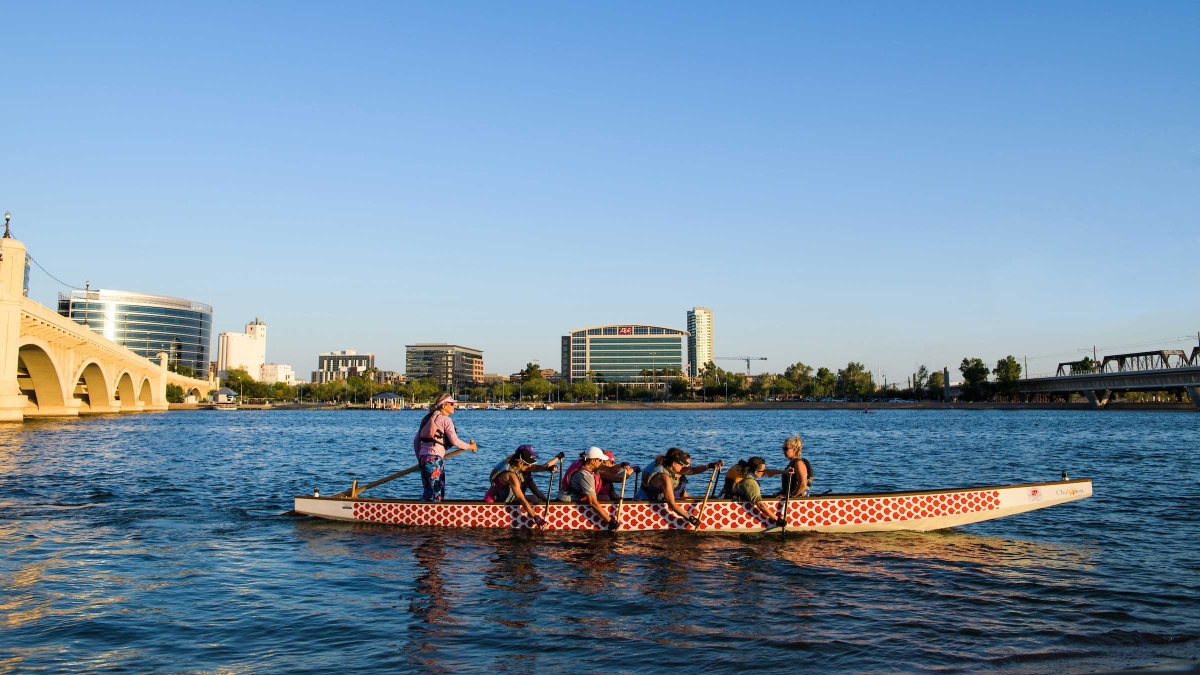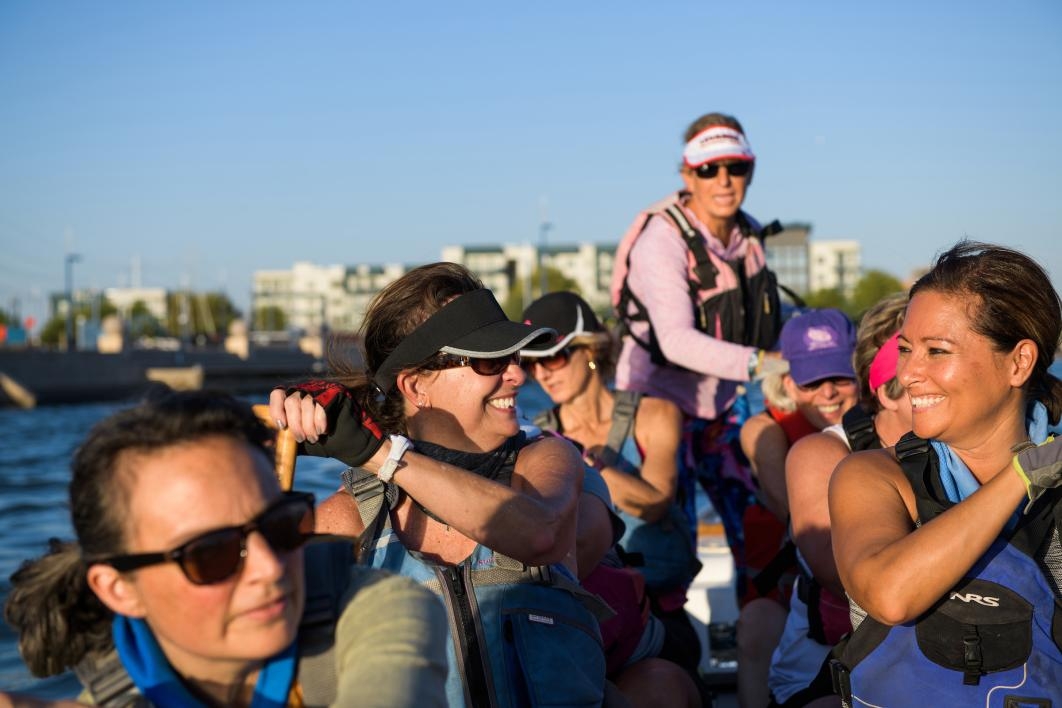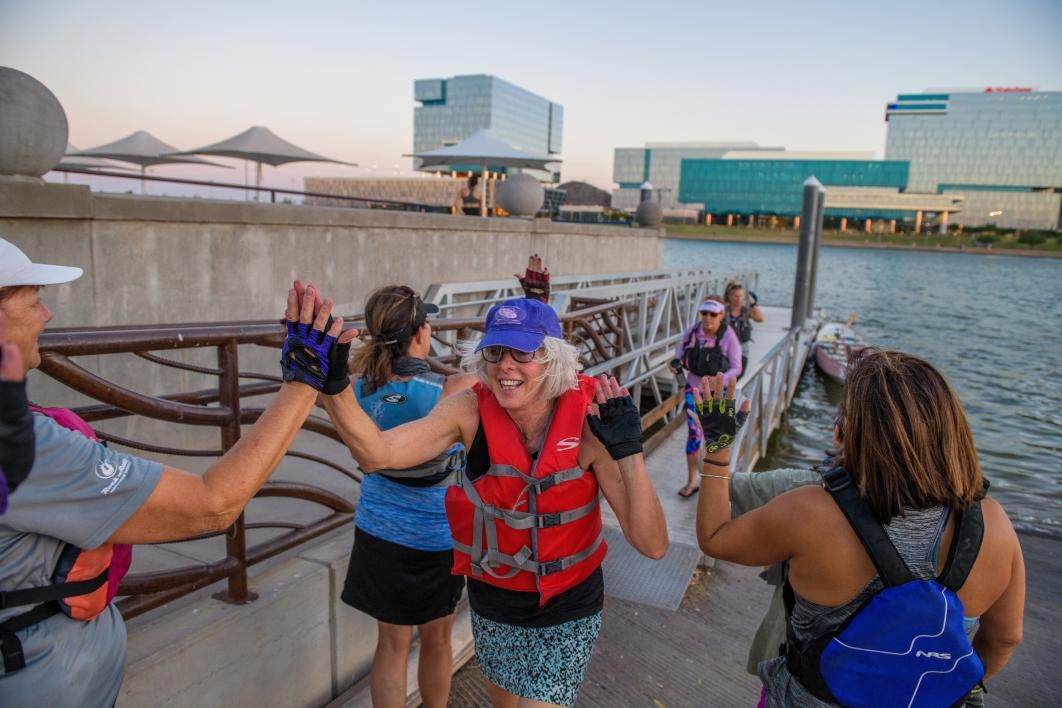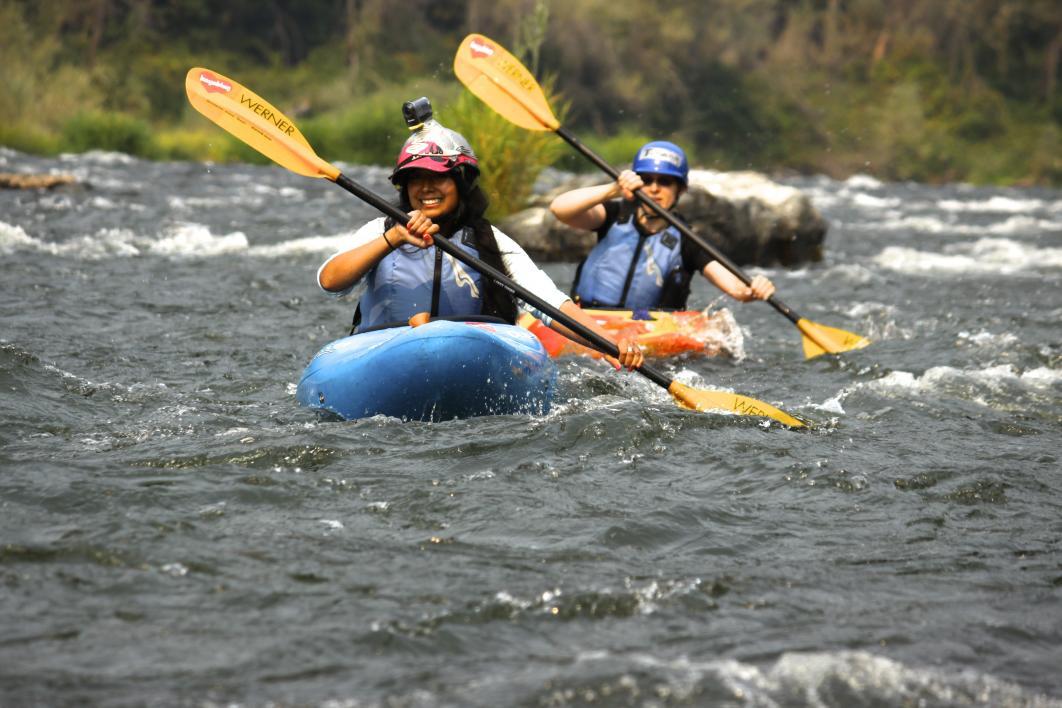Cancer draws a line across a life: before diagnosis, and after. Who you were then, and who you are now. For many, who they are now might be a surprise. They are people who navigate river rapids, jump off cliffs and paddle dragon boats in foreign waters — even if they didn’t consider themselves athletes before.
ASU alumna and breast cancer survivor Kathy Sullivan has been paddling with the Phoenix Desert Dragons for two years. The group, established in 2010, is one of 213 dragon boat teams across five continents that make up the International Breast Cancer Paddlers’ Commission. The activity gives her more than exercise and camaraderie with her teammates.
“It’s shown me that I can do something that I’ve set my mind to do,” said Sullivan, who earned a bachelor’s degree in psychology at ASU in 1994. “I’m growing and becoming more confident and a better person — I’m becoming me.”
The Dragons include about 35 active members, ranging in age from 30 to 79, who practice twice a week. In July, the team paddled at the IBCPC Participatory Dragon Boat Festival in Florence, Italy, along with more than 120 other teams. Melissa Adams is the team’s coach and a breast cancer survivor herself.
“I find my solace on the water,” she said. “Many of us come from a completely different life prior to our breast cancer experience, and we sometimes struggle with trying to figure out: Where do we go, what do we do, what is our new normal?”
Adams said many of the paddlers were not athletes beforehand but that after finding dragon boating they realized, “I’m totally capable of being an athlete, and a good one.”
Activity that empowers
The American Cancer Society encourages physical activity during and after cancer treatment, noting that exercise can offer physical and mental benefits — but that wasn’t always considered the case.
“In the past, people treated for cancer were told by their doctor to rest and reduce their physical activity,” said Dr. Anikar Chhabra, the director of sports medicine at Mayo Clinic Arizona. “What we’ve learned is that too much rest leads to loss of body function, muscular weakness, loss of motion in your joints, and stiffness leads to pain,” and research has shown that exercise is beneficial, he said. Now, doctors are urging patients to “go and try to do things.”
A number of programs help survivors do that — in ways that both challenge and empower them. First Descents offers free, life-changing adventures for young people (ages 18–39) affected by cancer. This includes adventure trips in the U.S. and around the world, as well as shorter weekend events in several communities.
ASU alumna Andrea Lopez went on a weeklong First Descents kayaking trip on the Rogue River in Oregon.
“It was an awakening,” she said. “When you’re going through cancer treatment, it’s scary. You have to be so cautious with everything, and First Descents kind of wiped that clean” by immersing participants in adventures. “Going through rapids in a river, your adrenaline and your survival skills — they’re all being tested. And it’s not like your survival skills being tested while you’re in the doctor’s office,” she said.
Activities include kayaking, climbing, windsurfing, hiking, bikepacking and ski mountaineering — which most participants don’t have experience doing.
“Adventure sports are innately empowering,” said Ray Shedd, First Descents’ director of development and marketing. “The secret sauce of our programming is the brutal, cold indifference of nature. We don’t dumb anything down because our participants are sick. We make everything fully accessible and fully adaptive, but those Class III rapids aren’t going to calm down because there are boaters who have cancer.” And participants face these challenges “with the tremendous support of their peers, fellow survivors.”
Lopez recalled falling out of her kayak and going through a bunch of rocks while holding onto someone else’s kayak.
“That was scary, and I got through it,” she said. “When I left, I just felt so empowered. I never knew I needed something like that.”
Lopez was diagnosed with a rare form of leukemia when she was 19. When you go through cancer, “your body kind of wears away a little,” she said. “I remember once attempting to run while on prednisone, and I fell flat on my face. I kind of avoided going back to the gym because I didn’t think I was capable of it.” But First Descents was different. On the water, she realized, “I’m good at this. I can do this.”
On the final day of Lopez’s trip, the kayakers completed their own run solo.
“It was so empowering because you got to do it by yourself. I did it without needing anyone,” she said, adding that she realized, “I am capable of a lot of things. I know what my body has gone through. I had a 40 percent chance of surviving, and I’m surviving. I did this — I’m here.”
After her trip, Lopez said she was motivated to be more active, and she took up running. “I go back to what I was able to do on the Rogue. I was able to go through all these rapids, I jumped off a cliff — I did all these things.”
Using the body to move forward
First Descents conducted research to evaluate the psychosocial benefits of its programming and found that participants’ self-esteem, body image and ability to cope with cancer and its ongoing effects increased while depression decreased.
The organization is working with health care providers to get its programs introduced to cancer survivors earlier, to “mitigate some of that psychosocial distress, depression, alienation and isolation so common in young adult survivors,” Shedd said.
“Most cancer centers realize the value of a multidisciplinary approach to cancer treatment,” Chhabra said. “Here at Mayo, we have a robust team of oncologists, radiation therapists, surgeons, social workers and psychologists” who work together to “optimize not only their physical health but also their mental health.” The patient’s well-being is important, he said. “As surgeons, we’re taught to fix what’s broken or take out what shouldn’t be there. But it is much bigger than that.”
Different types of cancer affect the body in different ways, and exercise should to be tailored to the individual, taking into account his or her treatment, pre-existing fitness level and other considerations. “Your physician should be there to tell you what’s safe and what’s not,” Chhabra said — but what’s safe and possible is much more than previously thought.
It’s part of a shifting mindset toward recovering from cancer. Standard advice used to be to warn breast cancer survivors against upper-body exercise to avoid lymphedema. Don McKenzie — a sports medicine physician and exercise physiologist at the University of British Columbia — challenged that, conducting a study in 1996 with survivors paddling dragon boats: They did not develop lymphedema and were happier and healthier. It sparked the creation of myriad dragon boat teams.
Recovery on Water (ROW) gets breast cancer survivors on the water in different boats — rowing shells. It runs a year-round team in Chicago and a four-day camp in northern Michigan. “A lot of times, women don’t feel like they can trust their bodies, that their bodies have betrayed them,” said Executive Director Jenn Junk. But in ROW, survivors are “using their bodies to move forward with their lives.”
Both Lopez and Sullivan said they became more open about their cancer after participating in these programs. Lopez said she realized “I should be proud of this. I got through two and a half years of treatment, and I’m still here.” She survived kayaking, and “I’m capable of doing so much more,” she said.
“When I was diagnosed with cancer, I would never talk about it,” Sullivan said. “I put it in the back of my mind. Sixteen years later, I came across this dragon boat team. Then I just started owning that I had cancer, and I wasn’t afraid to talk about it. Now I tell people that I’m on a dragon boat team for breast cancer survivors. And I feel that if I can come this far in my life, others can as well.”
Written by Allison Torres Burtka; top photo by Jarod Opperman. A version of this story was originally published on GlobalSport Matters, a joint initiative between ASU’s Global Sport Institute and the Walter Cronkite School of Journalism and Mass Communication. Read more stories about sport at globalsportmatters.com.
More Health and medicine

The science of sibling dynamics: Why we fight, how we relate and why it matters
We have Mother’s Day, Father’s Day and even Grandparents’ Day. But siblings? Usually they get a hand-me-down sweatshirt and, with any luck, a lifetime of inside jokes.But actually, there is a…

New study seeks to combat national kidney shortage, improve availability for organ transplants
Chronic kidney disease affects one in seven adults in the United States. For two in 1,000 Americans, this disease will advance to kidney failure.End-stage renal failure has two primary…

New initiative aims to make nursing degrees more accessible
Isabella Koklys is graduating in December, so she won’t be one of the students using the Edson College of Nursing and Health Innovation's mobile simulation unit that was launched Wednesday at Arizona…





